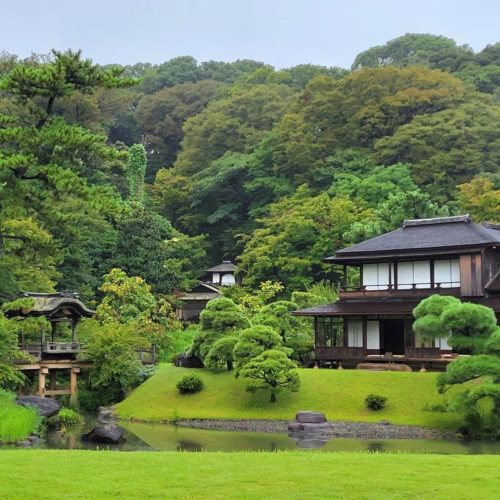Hello, this is _hiroyuki.ta. This time, we toured Sankeien Garden, a nationally designated scenic spot in Yokohama City, Kanagawa Prefecture. Sankeien is a Japanese garden that has been awarded two stars in the Michelin Green Guide, where you can enjoy old architecture and seasonal flowers. I departed from central Tokyo on a Harley Sports Glide (FLSB) and arrived in about an hour and a half. This time, we will introduce what Sankeien is, the route to Sankeien, the highlights of Sankeien, and the motorcycle parking lot at Sankeien.
What is Sankeien?

Sankeien Garden was opened in 1906 by Hara Sankei, a businessman who made his fortune in silk reeling and raw silk trading. Hara Sankei collected ancient art such as Buddhist paintings and tea ceremony utensils, and also purchased and relocated old buildings from Kyoto, Gifu, and other areas. As a result, 17 Japanese buildings are located on a site of 17.5 hectares. Among them, 10 buildings are designated as national important cultural properties. The garden also features aquascapes such as ponds and waterfalls, as well as flowering trees such as cherry blossoms and plum blossoms, so you can enjoy beautiful scenery in each season. Sankeien was designated as a national scenic spot in 2006.
Route to Sankeien
I took the Shuto Expressway from central Tokyo to Sankeien Garden. We left early in the morning as we expected heavy traffic on the Shuto Expressway. On the Shuto Expressway, I transferred from the Wangan line to the Yokohane line and got off at the Honmoku exit. From the Honmoku exit, we headed south on National Route 357, passing Honmoku Pier. After that, I entered Prefectural Route 21 and turned right at the Honmokucho intersection. On Prefectural Route 21, we could see Honmoku Sancho Park and Honmoku Sea Fishing Facility. After driving along Prefectural Route 21 for a while, I came to the Sankeien Entrance intersection. Turn left there and you will immediately see the main entrance to Sankeien Garden.
Highlights of Sankeien Garden
Sankeien has two areas: the inner garden and the outer garden. The inner garden is home to important cultural properties and scenic gardens, while the outer garden has walking paths rich in nature and a tea room. I first toured the inner garden.

There were the following highlights in the inner garden.
Rinshunkaku: This is a sukiya-style shoin that was built as a villa for the Kishu Tokugawa family in the early Edo period. The Kano school’s fusuma paintings and transom carvings are spectacular.
- Gekkaden: This is a gable-style building built at Kinzoin of Mimurotoji Temple during the Azuchi-Momoyama period. It consists of a cypress fan room and a bamboo room, and a statue of Kujaku Myoo, a national treasure, was enshrined in the alcove.
- Shunsoro: This is a tea room said to have been built by Oda Yurakusai during the Azuchi-Momoyama period. It is also called Nine Windows Pavilion because it has nine windows. The window offers a view of the garden.
- Former Tenzuji Temple Juto Tower Covered Hall: This covered hall is said to have been built by Toyotomi Hideyoshi to celebrate his mother’s long life. Inside the hidden hall is a five-ring pagoda called Kotobuki-to. The roof of the hall is made of cypress bark, and is decorated with carvings such as horsetails and phoenixes.
- Choshukaku: This is Mikasakaku, built by Tokugawa Iemitsu within Nijo Castle, and relocated by Kasuga no Tsubone. The roof is thatched with Japanese pine, and the interior features Kano Tan’yu’s paintings on sliding doors and Matsuo Basho’s haiku monument.
There were the following highlights in the garden.

- Former Tomyoji Temple Three-story Pagoda: This is a three-story pagoda that existed at Tomyoji Temple in Kyoto during the Muromachi period. The height is about 10 meters, and the roof is thatched with cypress bark. Trees such as cherry blossoms and autumn leaves are planted around the three-storied pagoda.
- Old Tokeiji Temple: This is a Buddhist temple built at Tokeiji Temple in Kyoto in the early Edo period. The roof is made of cypress bark and is a gabled structure. Inside the Buddhist temple, statues of Amida Nyorai and 16 Arhats are enshrined.
- Former Yaborihara Family Residence: This is a gassho-style private house built in Hida Takayama, Gifu Prefecture in the late Edo period. The roof is thatched and is approximately 10 meters high. Inside there is a hearth and a dirt floor.
- Sankei Memorial Hall: This is a memorial hall that displays Hara Sankei’s achievements and collections. You can see Hara’s own calligraphy and paintings as well as works by artists connected to Hara.
- Kakushokaku: This is a restored building that was Sankei Hara’s residence. It can also be used for meetings and parties.
Motorcycle parking lot at Sankeien Garden
Sankeien has motorcycle parking lots on the left and right of the main entrance. The number of machines is small, but they are available for free. The security guard will use colored cones to adjust the space according to the bikes entering and exiting. I arrived early in the morning so it was empty, but it can be full on weekends and holidays.
Summary
This time, I went on a tour to Sankeien Garden. Sankeien is a wonderful garden where you can feel the history and culture of Japan. It was really fun to walk around looking at the old buildings and flowers. If you go by bike, be aware of the parking situation. Sankeien is open all year round, but its appearance changes depending on the season and time of day. Please come and visit Sankeien Garden.
三溪園(Sankeien Garden)



